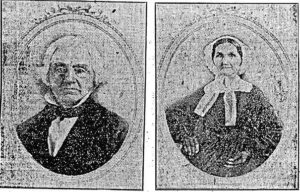
Nicoll and Euphius Halsey
The Halsey House was built in 1829 by Nicoll Halsey, a politician, business owner, and emancipator.
Nicoll Halsey was the son of Silas Halsey, a politician and farm who was Ovid town supervisor, a member of the New York State Assembly, elected for a term to the US House of Representatives, and also was elected to the New York State Senate. Nicoll was born in 1782, and like his father and brother pursued a career in law and politics. He attended Columbia University, studying political philosophy, constitutional law, and the ideals of the Enlightenment.
He married Euphius McDowell in 1806, and fathered Hannah, Rober, William, Richard, Emma Jane, Margaret, Emma (2nd), Henry, Waren, and Mortimer. According to the history of Tompkins County, Nicoll Halsey came from Ovid in 1808, and settled in what is now Halseyville. He built a grist-mill of scored logs, and had the mill-stones brought from Pennsylvania.
He eventually ran for office, and was elected to the New York State Assembly in 1816. He championed causes such as civil liberties, educational reform, and the abolition of slavery. He later became a US Congressman in 1824, and continued to promote his progressive agenda and supported the American System, an ambitious national program of President John Quincy Adams.
Halsey’s greatest legacy was his steadfast advocacy for the rights and dignity of all Americans. He was an ardent abolitionist and tirelessly fought against the institution of slavery. Halsey firmly believed that the principles upon which the United States was founded—equality, liberty, and justice—were incompatible with the institution of slavery. He used his position in Congress to push for the gradual emancipation of slaves, an incredibly controversial stance at the time. Despite facing significant opposition, Halsey’s moral conviction and persuasive arguments won him many allies in the fight against slavery.
Nicoll Halsey he retired from public life in 1838 and returned to his Halseyville farm and mill. He died in 1865 while visiting Michigan, and is buried in Grove Cemetery in Trumansburg.
Sources:
New York Historic, https://nyhistoric.com/2013/08/halsey-house/
US House of Representatives Archives, https://history.house.gov/People/Listing/H/HALSEY,-Nicoll-(H000089)/
Halsey genealogy, https://tompkins.nygenweb.net/cemeteries/halsey_farm_plot.htm
Southhampton History Museum, https://www.southamptonhistory.org/post/deep-dive-exploring-the-exhibits-21
Blogspot, https://bamaplanter.blogspot.com/2016/03/euphius-mcdowell-halsey-1784-1870.html